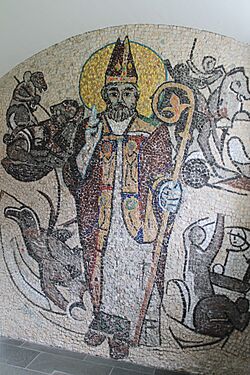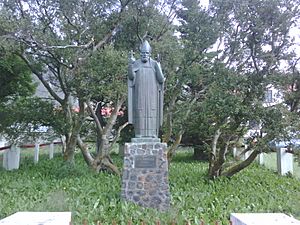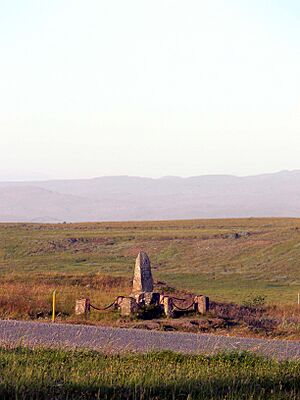Jón Arason facts for kids
Quick facts for kids The Right Reverend Jón Arason |
|
|---|---|
| Bishop of Hólar | |

Bishop Arason
|
|
| Church | Roman Catholic |
| Diocese | Hólar |
| Appointed | 22 December 1520 |
| In Office | 1524–1550 |
| Predecessor | Gottskálk grimmi Nikulásson |
| Successor | Ólafur Hjaltason |
| Orders | |
| Ordination | 1504 |
| Consecration | 1524 by Olav Engelbrektsson |
| Personal details | |
| Born | 1484 Gryta, Iceland |
| Died | 7 November 1550 Skalholt, Iceland |
| Nationality | |
Jón Arason (1484 – November 7, 1550) was an important Icelandic Roman Catholic bishop and poet. He is famous for his fight against the Protestant Reformation being forced upon Iceland. He was executed because of his strong beliefs.
Contents
Early Life and Becoming a Bishop
Jón Arason was born in a place called Gryta. He received his education at Munkaþverá, which was a Benedictine abbey in Iceland. Around 1504, he became a Catholic priest.
He caught the attention of Gottskálk Nikulásson, who was the bishop of Hólar. Jón was sent on two important trips to Norway. When Bishop Gottskálk passed away in 1520, Jón Arason was chosen to take his place as the bishop of Hólar. He officially became a bishop in 1524.
The other bishop in Iceland, Ögmundur Pálsson of Skálholt, did not want Jón to become bishop. He even tried to arrest Jón in 1522. But Jón managed to escape Iceland on a German ship. The two bishops later made peace in 1525. Bishop Ögmundur also opposed the new Lutheranism religion coming to Iceland. However, he was old and blind, so his efforts were not very effective.
Jón Arason's Family Life
In medieval Iceland, priests often had families, even if they didn't officially marry. Jón Arason had a family with his partner, Helga Sigurðardóttir. They had several children together. Helga's family was powerful, which helped Jón gain important allies. In 1522, Jón officially recognized four of his children as his heirs: Ari, Björn, Magnús, and Þórunn.
Fighting for Catholic Iceland
Bishop Jón had a big disagreement with the king, King Christian III. The king wanted to bring Lutheranism to Iceland, but Jón refused to support it. At first, Jón only defended his position. But in 1548, he decided to take a stronger stand.
He and Bishop Ögmundur decided to work together against the Lutherans. However, Bishop Ögmundur was too ill to continue. He was soon sent away to Denmark.
Jón's continued fight was partly due to his strong religious beliefs. He also felt a deep love for his country and its culture. He believed that staying Catholic would help Iceland keep its traditions. Jón received a letter of support from Pope Paul III. This encouraged him to keep fighting for Iceland to remain Catholic.
Battles and Capture
Jón's sons and daughters helped him in his fight. They joined him in various battles. However, during the Battle of Sauðafell, Jón and two of his sons, Ari and Björn, were captured. Their main enemy, Daði Guðmundsson, took them prisoner. They were then handed over to the king's officer, called a bailiff.
There are stories that say one of Jón's daughters tried to gather her own forces to save him. But her efforts were not successful.
In 1550, Jón, Ari, and Björn were executed. This marked the end of Jón's campaign to keep Iceland Catholic. Christian Skriver, the king's bailiff who ordered their execution, was later killed. Fishermen who supported Jón were said to have been convinced by Jón's powerful daughter, Þórunn Jónsdóttir, to kill him. Skriver's death was both revenge for Jón's death and part of the conflict between Catholics and Lutherans.
Jón Arason's Legacy
A famous story tells that as Jón was about to be executed, a priest named Sveinn was with him. Sveinn tried to comfort Jón by saying, Líf er eftir þetta, herra! This means, "There is a life after this one, Sire!" Jón turned to Sveinn and replied, Veit ég það, Sveinki! which means, "That I know, little Sveinn!"
This phrase, veit ég það, Sveinki, is now a well-known saying in Iceland. It is used when someone states something that is very obvious.
Gunnar Gunnarsson wrote a book called Jón Arason in 1930. It is a fictional story about Jón's life. The book was first written in Danish and has been translated into other languages, including English.



